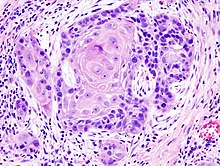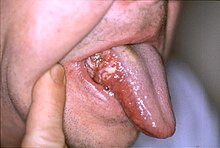Oral carcinoma
| Classification according to ICD-10 | |
|---|---|
| C01 | Malignant neoplasm of the base of the tongue |
| C02 | Malignant neoplasm of other and unspecified parts of the tongue |
| C03 | Malignant neoplasm of the gums |
| C04 | Malignant neoplasm of the floor of the mouth |
| C05 | Malignant neoplasm of the palate |
| C06 | Malignant neoplasm in other and unspecified parts of the mouth |
| ICD-10 online (WHO version 2019) | |
The term oral carcinoma includes all malignant tumors of the oral cavity and tongue ; 80 to 90 percent of all cases are squamous cell carcinomas . Other types of tumors, such as adenocarcinoma arising from the seromucosal mucous membrane , are rare. Oral carcinomas belong to the class of head and neck tumors .
causes
The main risk factors for the occurrence of oral cancer are chronic tobacco or alcohol abuse ; other factors are much less common. Chronic tobacco or alcohol abuse increases the risk of disease by up to 6 times, and when both risk factors are combined there is an up to 30 times higher risk. For lip cancer, the contact of the lip with the cigarette, regardless of the total amount of tobacco consumption, is considered a major risk factor. Furthermore, the use of chewing tobacco is a predisposing factor for the development of oral cancer. In addition to the consumption of tobacco or alcohol, an unbalanced diet, such as excessive consumption of meat or fried food, can increase the risk of developing carcinoma in the oral cavity.
Epidemiology
The carcinomas of the oral cavity occur predominantly after the 5th decade of life and have a peak between the ages of 60 and 70. Men are affected twice as often as women. The Center for Cancer Registry Data and the Society of Epidemiological Cancer Registries in Germany determined for 2014 that 16.9 men out of 100,000 develop oral or throat cancer each year, but only 5.9 women. The survival rate 5 years after diagnosis is 43 percent lower for men than 53 percent for women. The mortality of oral carcinoma has geographical differences, in France it is for. B. four times as high as in Germany. In the USA, too, the incidence is higher in both men and women than in Germany. Oral carcinoma ranks sixth worldwide with six percent of all cancers. It is the fifth most common cancer in men and the 15th most common in women (as of 2012). The five-year survival of patients diagnosed with oral cancer in Germany is around 55 percent.
pathology
Emergence
Oral carcinoma develops in the rarest cases without precancerous lesions , which - depending on the probability of degeneration - are divided into facultative (low probability) and obligatory (probability ≥ 30%) precancerous lesions. An optional precancerous condition of oral carcinoma is leukoplakia and is most often found on the cheek mucosa and in the corner of the mouth. The obligatory precanceroses are overall rarer than leukoplakia and often malignant degenerate at the time of diagnosis. This includes B. Bowen's disease (or erythroplasia Queyrat), they are often located on the gingiva or the underside of the tongue.
localization
According to a study by DÖSAK (German-Austrian-Swiss working group for tumors in the jaw and face area) around 45 percent of all oral carcinomas are located on the floor of the mouth. The tumors on the tongue (tongue cancer) follow with about 20 percent. Other locations, but much less frequently, are the gingiva , upper lip and cheek mucosa , in order of frequency . Oral cancer often develops multifocal, which explains the high rate of recurrence .
morphology
The two forms of oral cancer growth differ from one another prognostically:
- Ulcerous (chronic) form : This inwardly (endophytic) growing form usually has a decay crater. The prognosis depends on the location, so it is better on the lip than e.g. B. on the floor of the mouth or on the tongue. The ulcerative form makes up about 99 percent. Histologically , this is a slightly differentiated squamous cell carcinoma.
- Verrucous (wart-like) form : This outward (exophytic) growing form makes up about one percent. The tumor grows slowly and later metastasizes . In histology, it is a highly differentiated squamous cell carcinoma.
Metastases
The tumors of the oral cavity and the two front third of the tongue metastasize primarily almost never about the blood (hematogenous), but via the lymph into the submandibular , rare in the submental or lower on the neck nearby lymph nodes . The frequency of lymphogenic metastasis increases with the tumor stage . At the time the tumor is diagnosed, it is around 30 to 40 percent (T1 stage around 10–15 percent, in stage T4 with 55–75 percent).
At the time of diagnosis, tumors of the gingiva and the buccal mucosa already show metastases in the regional lymph nodes in a larger percentage. In the case of gingival tumors, lymph nodes of the throat , and in the case of cheek mucosal tumors, parotid lymph nodes can also be affected.
Symptoms and Diagnosis
The complaints are initially unspecific. Initial symptoms can include pain, bad breath, and speech impairment.
A trial excision should be made in all suspected cases . In addition, if there is a suspicion, computed tomography or magnetic resonance imaging of the primary tumor and the lymphatic system should be performed. The advantage of magnetic resonance imaging for tumors of the tongue and the floor of the mouth is the good soft tissue contrast. If the infiltration of the bone is to be clarified, magnetic resonance tomography is less helpful; skeletal scintigraphy or computed tomography in the special bone window are suitable here . In the case of advanced tumor diseases (from tumor stage T3 or proven lymph node metastases ), haematogenic metastasis of the lungs , liver and adrenal glands should be checked.
therapy
Surgical therapy
Depending on the stage and extent of the tumor, a resection with a correspondingly large safety margin (approx. 1 cm) may be sufficient. If the findings are extensive, a partial resection of the lower jaw may be necessary. If several regions of the oral cavity are exceeded, a combined resection of z. B. tongue, floor of the mouth and roof of the mouth. In the case of lymph node metastases, selective to radical neck dissection may be necessary , depending on the stage .
Radiological therapy
In the case of small tumors of the tongue and the hard palate, radiation therapy alone can lead to effective tumor control. For larger tumors, a more aggressive approach in the form of a combination of surgical and radiological therapy is recommended.
literature
- A. Burkhardt: Premalignant changes in the oral mucosa. In: Pathologist. 6 (1985), p. 119
- Riede, Schäfer: General and special pathology. 3rd edition, p. 713.
- RH Brakenhoff, BJM Braakhuis: Development, Treatment and Prevention of Oral Cancer . In: Fanconi Anemia: A Handbook for Families. Pp. 275-279. (PDF file; 86 kB)
Web links
- Early detection of oral cancer (PDF; 110 kB) - patient information from the German Dental Association and the German Society for Dentistry, Oral and Maxillofacial Medicine
Individual evidence
- ↑ S3 guideline diagnosis and treatment of oral carcinoma " of the German Society of Oral and Maxillofacial Surgery. In: AWMF Online (September 2012)
- ↑ a b Joint publication of the Center for Cancer Registry Data and the Society of Epidemiological Cancer Registries in Germany: Cancer in Germany for 2013/2014. Ed .: Robert Koch Institute. 11th edition edition. Berlin 2017, ISBN 978-3-89606-288-8 , doi : 10.17886 / rkipubl-2017-007 .
- ↑ Oral cancer in men is the fifth most common cancer (in: kma-online.de) ( page can no longer be accessed , search in web archives ) Info: The link was automatically marked as defective. Please check the link according to the instructions and then remove this notice.
- ↑ S. Listl, L. Jansen u. a .: Survival of patients with oral cavity cancer in Germany. In: PloS one. Volume 8, number 1, 2013, p. E53415, ISSN 1932-6203 . doi: 10.1371 / journal.pone.0053415 . PMID 23349710 . PMC 3548847 (free full text)


